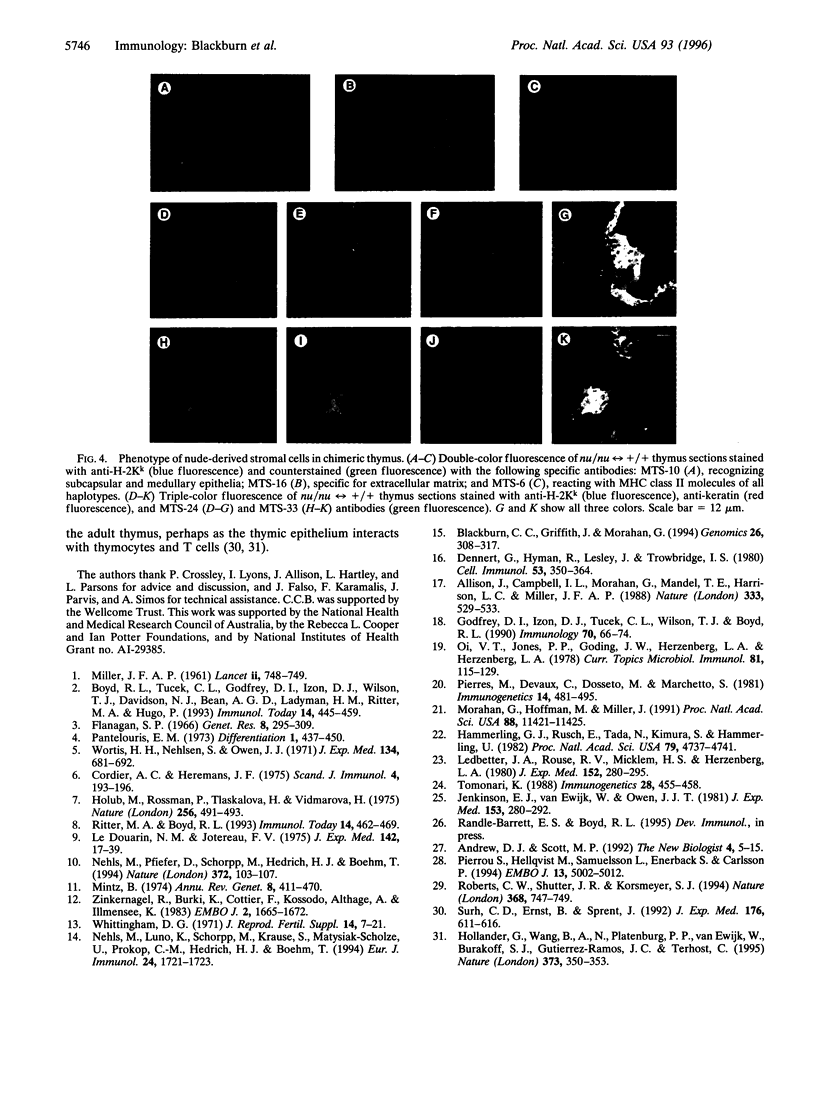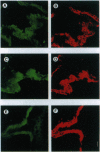Abstract
The nude mutation (nu) causes athymia and hairlessness, but the molecular mechanisms by which it acts have not been determined. To address the role of nu in thymogenesis, we investigated whether all or part of the nude thymic epithelium could be rescued by the presence of wild-type cells in nude <--> wild-type chimeric mice. Detailed immunohistochemical analyses revealed that nude-derived cells could persist in the chimeric thymus but could not contribute to cortical or medullary epithelial networks. Nude-derived cells, present in few clusters in the medulla, expressed markers of a rare subpopulation of adult medullary epithelium. The thymic epithelial rudiment of nude mice strongly expressed these same markers, which may therefore define committed immature thymic epithelial precursor cells. To our knowledge, these data provide the first evidence that the nu gene product acts cell-autonomously and is necessary for the development of all major subpopulations of mature thymic epithelium. We propose that nu acts to regulate growth and/or differentiation, but not determination, of thymic epithelial progenitors.
Full text
PDF




Images in this article
Selected References
These references are in PubMed. This may not be the complete list of references from this article.
- Allison J., Campbell I. L., Morahan G., Mandel T. E., Harrison L. C., Miller J. F. Diabetes in transgenic mice resulting from over-expression of class I histocompatibility molecules in pancreatic beta cells. Nature. 1988 Jun 9;333(6173):529–533. doi: 10.1038/333529a0. [DOI] [PubMed] [Google Scholar]
- Andrew D. J., Scott M. P. Downstream of the homeotic genes. New Biol. 1992 Jan;4(1):5–15. [PubMed] [Google Scholar]
- Blackburn C. C., Griffith J., Morahan G. A high-resolution map of the chromosomal region surrounding the nude gene. Genomics. 1995 Mar 20;26(2):308–317. doi: 10.1016/0888-7543(95)80215-8. [DOI] [PubMed] [Google Scholar]
- Boyd R. L., Tucek C. L., Godfrey D. I., Izon D. J., Wilson T. J., Davidson N. J., Bean A. G., Ladyman H. M., Ritter M. A., Hugo P. The thymic microenvironment. Immunol Today. 1993 Sep;14(9):445–459. doi: 10.1016/0167-5699(93)90248-J. [DOI] [PubMed] [Google Scholar]
- Cordier A. C., Heremans J. F. Nude mouse embryo: ectodermal nature of the primordial thymic defect. Scand J Immunol. 1975;4(2):193–196. doi: 10.1111/j.1365-3083.1975.tb02616.x. [DOI] [PubMed] [Google Scholar]
- Dennert G., Hyman R., Lesley J., Trowbridge I. S. Effects of cytotoxic monoclonal antibody specific for T200 glycoprotein on functional lymphoid cell populations. Cell Immunol. 1980 Aug 1;53(2):350–364. doi: 10.1016/0008-8749(80)90335-4. [DOI] [PubMed] [Google Scholar]
- Flanagan S. P. 'Nude', a new hairless gene with pleiotropic effects in the mouse. Genet Res. 1966 Dec;8(3):295–309. doi: 10.1017/s0016672300010168. [DOI] [PubMed] [Google Scholar]
- Godfrey D. I., Izon D. J., Tucek C. L., Wilson T. J., Boyd R. L. The phenotypic heterogeneity of mouse thymic stromal cells. Immunology. 1990 May;70(1):66–74. [PMC free article] [PubMed] [Google Scholar]
- Holländer G. A., Wang B., Nichogiannopoulou A., Platenburg P. P., van Ewijk W., Burakoff S. J., Gutierrez-Ramos J. C., Terhorst C. Developmental control point in induction of thymic cortex regulated by a subpopulation of prothymocytes. Nature. 1995 Jan 26;373(6512):350–353. doi: 10.1038/373350a0. [DOI] [PubMed] [Google Scholar]
- Holub M., Rossmann P., Tlaskalova H., Vidmarova H. Thymus rudiment of the athymic nude mouse. Nature. 1975 Aug 7;256(5517):491–493. doi: 10.1038/256491a0. [DOI] [PubMed] [Google Scholar]
- Hämmerling G. J., Rüsch E., Tada N., Kimura S., Hämmerling U. Localization of allodeterminants on H-2Kb antigens determined with monoclonal antibodies and H-2 mutant mice. Proc Natl Acad Sci U S A. 1982 Aug;79(15):4737–4741. doi: 10.1073/pnas.79.15.4737. [DOI] [PMC free article] [PubMed] [Google Scholar]
- Jenkinson E. J., Van Ewijk W., Owen J. J. Major histocompatibility complex antigen expression on the epithelium of the developing thymus in normal and nude mice. J Exp Med. 1981 Feb 1;153(2):280–292. doi: 10.1084/jem.153.2.280. [DOI] [PMC free article] [PubMed] [Google Scholar]
- Le Douarin N. M., Jotereau F. V. Tracing of cells of the avian thymus through embryonic life in interspecific chimeras. J Exp Med. 1975 Jul 1;142(1):17–40. doi: 10.1084/jem.142.1.17. [DOI] [PMC free article] [PubMed] [Google Scholar]
- Ledbetter J. A., Rouse R. V., Micklem H. S., Herzenberg L. A. T cell subsets defined by expression of Lyt-1,2,3 and Thy-1 antigens. Two-parameter immunofluorescence and cytotoxicity analysis with monoclonal antibodies modifies current views. J Exp Med. 1980 Aug 1;152(2):280–295. doi: 10.1084/jem.152.2.280. [DOI] [PMC free article] [PubMed] [Google Scholar]
- MILLER J. F. Immunological function of the thymus. Lancet. 1961 Sep 30;2(7205):748–749. doi: 10.1016/s0140-6736(61)90693-6. [DOI] [PubMed] [Google Scholar]
- Mintz B. Gene control of mammalian differentiation. Annu Rev Genet. 1974;8:411–470. doi: 10.1146/annurev.ge.08.120174.002211. [DOI] [PubMed] [Google Scholar]
- Morahan G., Hoffmann M. W., Miller J. F. A nondeletional mechanism of peripheral tolerance in T-cell receptor transgenic mice. Proc Natl Acad Sci U S A. 1991 Dec 15;88(24):11421–11425. doi: 10.1073/pnas.88.24.11421. [DOI] [PMC free article] [PubMed] [Google Scholar]
- Nehls M., Lüno K., Schorpp M., Krause S., Matysiak-Scholze U., Prokop C. M., Hedrich H. J., Boehm T. A yeast artificial chromosome contig on mouse chromosome 11 encompassing the nu locus. Eur J Immunol. 1994 Jul;24(7):1721–1723. doi: 10.1002/eji.1830240742. [DOI] [PubMed] [Google Scholar]
- Nehls M., Pfeifer D., Schorpp M., Hedrich H., Boehm T. New member of the winged-helix protein family disrupted in mouse and rat nude mutations. Nature. 1994 Nov 3;372(6501):103–107. doi: 10.1038/372103a0. [DOI] [PubMed] [Google Scholar]
- Oi V. T., Jones P. P., Goding J. W., Herzenberg L. A., Herzenberg L. A. Properties of monoclonal antibodies to mouse Ig allotypes, H-2, and Ia antigens. Curr Top Microbiol Immunol. 1978;81:115–120. doi: 10.1007/978-3-642-67448-8_18. [DOI] [PubMed] [Google Scholar]
- Pantelouris E. M. Athymic development in the mouse. Differentiation. 1973 Dec;1(6):437–450. doi: 10.1111/j.1432-0436.1973.tb00143.x. [DOI] [PubMed] [Google Scholar]
- Pierres M., Devaux C., Dosseto M., Marchetto S. Clonal analysis of B- and T-cell responses to Ia antigens. I. Topology of epitope regions on I-Ak and I-Ek molecules analyzed with 35 monoclonal alloantibodies. Immunogenetics. 1981 Dec;14(6):481–495. doi: 10.1007/BF00350120. [DOI] [PubMed] [Google Scholar]
- Pierrou S., Hellqvist M., Samuelsson L., Enerbäck S., Carlsson P. Cloning and characterization of seven human forkhead proteins: binding site specificity and DNA bending. EMBO J. 1994 Oct 17;13(20):5002–5012. doi: 10.1002/j.1460-2075.1994.tb06827.x. [DOI] [PMC free article] [PubMed] [Google Scholar]
- Ritter M. A., Boyd R. L. Development in the thymus: it takes two to tango. Immunol Today. 1993 Sep;14(9):462–469. doi: 10.1016/0167-5699(93)90250-O. [DOI] [PubMed] [Google Scholar]
- Roberts C. W., Shutter J. R., Korsmeyer S. J. Hox11 controls the genesis of the spleen. Nature. 1994 Apr 21;368(6473):747–749. doi: 10.1038/368747a0. [DOI] [PubMed] [Google Scholar]
- Surh C. D., Ernst B., Sprent J. Growth of epithelial cells in the thymic medulla is under the control of mature T cells. J Exp Med. 1992 Aug 1;176(2):611–616. doi: 10.1084/jem.176.2.611. [DOI] [PMC free article] [PubMed] [Google Scholar]
- Tomonari K. A rat antibody against a structure functionally related to the mouse T-cell receptor/T3 complex. Immunogenetics. 1988;28(6):455–458. doi: 10.1007/BF00355379. [DOI] [PubMed] [Google Scholar]
- Whittingham D. G. Culture of mouse ova. J Reprod Fertil Suppl. 1971 Jun;14:7–21. [PubMed] [Google Scholar]
- Wortis H. H., Nehlsen S., Owen J. J. Abnormal development of the thymus in "nude" mice. J Exp Med. 1971 Sep 1;134(3 Pt 1):681–692. doi: 10.1084/jem.134.3.681. [DOI] [PMC free article] [PubMed] [Google Scholar]
- Zinkernagel R. M., Bürki K., Cottier F., de Kossodo S., Althage A., Illmensee K. Thymus differentiation and T-cell specificity in nu/nu +/+ mouse aggregation chimaeras. EMBO J. 1983;2(10):1665–1672. doi: 10.1002/j.1460-2075.1983.tb01641.x. [DOI] [PMC free article] [PubMed] [Google Scholar]






